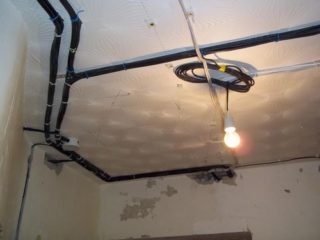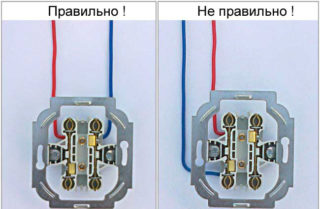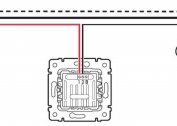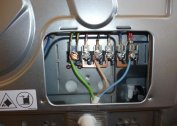When buying real estate in a new building or before carrying out major repairs of secondary housing, you need to decide how to make the electrical wiring in the apartment: on the ceiling or floor. Each method has its pros and cons, which determine the convenience of work, material costs, the life of the system and possible complications in the future. To make the right decision, you need to get acquainted with the features of this direction of construction.
Ceiling or floor wiring
To choose the method of laying the cable, you should consider the advantages and disadvantages of each option.
Advantages of choosing a lower level:
- convenience of work; no need to use a stepladder;
- safety, excludes the possibility of falling or hitting your head on a plate;
- ease of closing communications with mortar or floorboards.
Negative sides are also available. The concrete slab undergoes shrinkage due to which the cable may be crushed. In wooden structures, rodents and insects can damage it. You need to decide how to close the wiring on the walls, through which it is brought to the lighting group.
Advantages of wiring electricians on the ceiling in the apartment:
- safety in terms of lack of mechanical stress;
- the ability to carry out installation in several ways;
- less activity, as laying is closer to consumers.
The downside is that working at height is difficult, uncomfortable and dangerous. In addition, the master needs to figure out how to hide the wiring on the ceiling so that it is correct and beautiful.
Cost comparison
Any master seeks to minimize construction costs. If it is done by hand, the estimate will consist only of a list of materials if the tools were purchased in advance.
Simple calculations show that the ceiling version is more profitable in such aspects:
- Less wiring required. It passes from the input box directly to the lighting fixtures. Branches of small length go to sockets and switches.
- Consumption of protective products. When placing cables in the floor, it is necessary to use an expensive steel pipe, and corners are corrugated fragments. On the ceiling, even if gating is done, a fairly affordable plastic duct is available.
- Depreciation of equipment. With the lower gasket, you need to make the strobes on the walls. To do this, you will need many discs for grinders and chisels for a punch.
- Time factor. For many masters, it matters, especially if they are limited in time.
Despite the fact that you have to hide the wires on the ceiling, this method is more economical in terms of financial and time costs.
Laying electrics on the internal voids of floor slabs
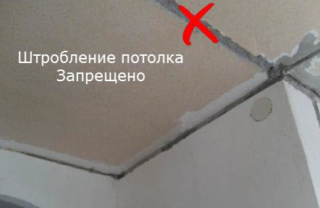 A prefabricated house is being constructed using floor slabs that have circular channels inside that extend along the entire length of the product. These voids are an ideal place for a hidden transmission of communications. To find the channels, you need to use the project documentation or make several test holes. After this, you need to decide how the wiring will take place on the ceiling, in the corrugation or without.A plastic channel will facilitate subsequent repair and modification of communications.
A prefabricated house is being constructed using floor slabs that have circular channels inside that extend along the entire length of the product. These voids are an ideal place for a hidden transmission of communications. To find the channels, you need to use the project documentation or make several test holes. After this, you need to decide how the wiring will take place on the ceiling, in the corrugation or without.A plastic channel will facilitate subsequent repair and modification of communications.
After determining the location of the voids, the following actions are carried out:
- A line corresponding to the passage of the cavity is drawn in the center of the plate.
- The place or places where the lighting fixtures will be installed is determined. They are combined with an axial line. Holes with a diameter of up to 30 mm are drilled at these points.
- Opposite the junction box, another hole is made, combined with the longitudinal line.
- A piece of hard iron wire is taken. A corrugated tube is attached to it. If wiring without corrugation over the ceiling is selected, a cable is wound around the wire.
- The wire is inserted into the hole near the box and pushed through the cavity until it reaches the hole under the chandelier. There she is captured by a hook and pulled into the room.
- The wire is pulled, along with it the tube or wiring is removed.
Holes must be covered with plaster to prevent mold, fungus and insects that may appear in the slabs from entering the room.
Open Type Wiring
If the house is wooden, according to the rules of fire safety, its electrification is carried out in an open way. Another reason is the lack of cavities in the concrete slab. A parallel, sequential, or combined arrangement of lines is selected.
Open wiring on the ceiling is done by attaching lines to the surfaces of walls and ceilings.
For this, the following devices are used:
- smooth and corrugated plastic pipes;
- metal profiles of round or rectangular section;
- cable channels made of PVC;
- ceramic insulators;
- steel strings;
- baseboards and platbands.
Open installation is carried out in the following sequence:
- Charting, marking. Drawing a route of passage of the highway and drilling points.
- Drilling holes for fasteners. The distance between them is determined by the weight of the structure and the degree of sagging.
- Installation in holes of plastic dowels. If the installation is carried out on drywall or plywood, clamping products are placed.
- Fastening insulators, clips, couplings and other parts for fixing the trunk.
- Channel installation for cable or carrier string.
- Pulling wiring into the pipeline, laying in a plastic channel, fasteners to insulators or strings.
If communication is not isolated, you need to choose products with non-combustible insulation, resistant to mechanical damage.
Laying wires in strobes and flexible sleeves
 Stowing is the best way to hide wiring not only from environmental influences, but also visually.
Stowing is the best way to hide wiring not only from environmental influences, but also visually.
This procedure is carried out in the following sequence:
- Making grinder parallel cuts at a distance of 3-4 cm and a depth of 3 cm.
- Knocking out material between slots with a perforator.
- Drilling holes for sockets, boxes and switches.
- Laying the cable in the strobes, fixing it with plaster or staples.
- Filling the grooves with cement mortar followed by putty.
Using a corrugated tube will help replace the cable after it is worn or damaged without breaking the base.
The use of flexible hoses when installing external wiring initially eliminates the possibility of a fire when a fire ignites or shorts out. The pipeline must be positioned so that it is not less than 3 cm from combustible surfaces or metal frame parts of suspended structures in which it is convenient to hide it. Fastening to the plate must be carried out using non-fusible products.
How to hide the wiring on the ceiling
There are the following ways to mask open-paved communications:
- close the wires with boxes;
- install a stretch ceiling;
- to mount bulk forms of drywall.
External structures can be used to place plastic boxes, the lids of which must be tightly closed after connecting the wires.
Power Outlets
Sockets must be connected when the electricity is disconnected on the input shield.
The sequence of actions is as follows:
- Prepare the socket, thread the cable through it.
- Lubricate the glass with putty and insert it into the hole.
- Strip the ends of the wires, attach them to the contacts.
- Fasten the housing to the socket.
- Attach the cover.
In conclusion, you need to check the strength of the fastening with a plug.
What to do when flooding
If quality materials are selected, their installation is carried out correctly, flooding does not pose a danger to the electrical system of the apartment.
The most important thing in this situation is to dry the channels so that mold does not develop in them. To do this, turn off the room, remove the sockets and switches from the sockets, remove the lamps. To get rid of damp faster, it is better to use a heat gun.
For ceiling wiring, you can use a combined installation option. The walls are made strobes, which after laying communications closed up. Then any type of finish is applied. Floor slabs are not recommended to be weakened by gating, so the lines are fixed to them in an open way. Then the installation of a stretch fabric or suspension system made of drywall, plastic or metal rails. The result - high-quality wiring and flat surfaces.

